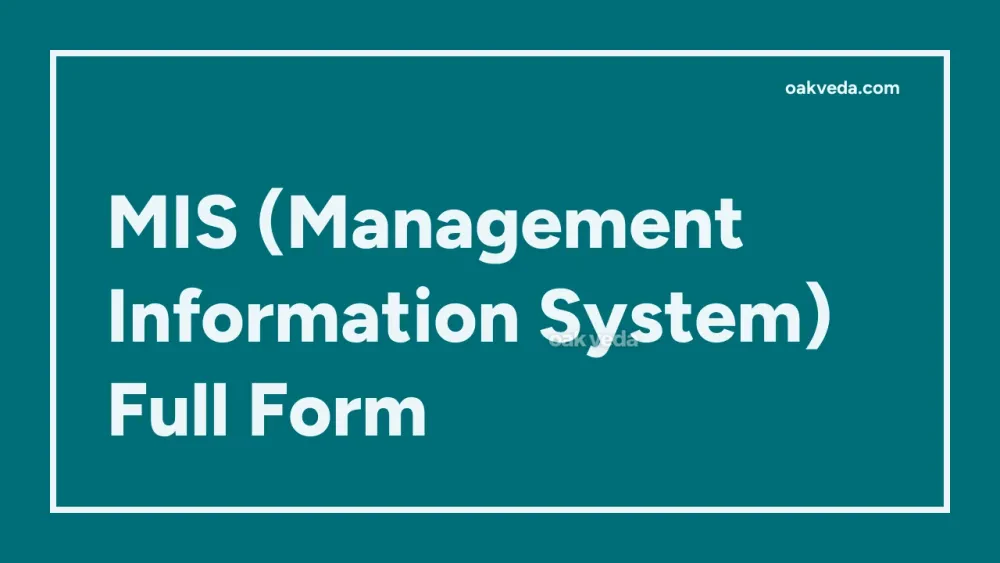
What is the Full Form of MIS?
The full form of MIS is Management Information System. This term refers to a comprehensive system that integrates people, technology, and processes to collect, process, store, and distribute information for effective decision-making within an organization.
What is Management Information System?
A Management Information System (MIS) is a crucial tool in modern business operations. It's a computerized system that combines hardware, software, and human resources to gather, analyze, and present data in a format that supports managerial decision-making. MIS plays a vital role in helping organizations measure the benefits of investments in personnel, equipment, and procedures.
Origin and Development of Management Information System
The concept of MIS emerged in the 1960s with the advent of computer technology in business. Initially, it focused on automating data processing tasks. Over time, as technology advanced, MIS evolved to encompass more complex functions, including data analysis, reporting, and strategic planning support.
How does Management Information System work?
MIS operates by collecting data from various sources within an organization, such as sales, finance, human resources, and production. This data is then processed, analyzed, and presented in a format that managers can use to make informed decisions. The system typically involves:
- Data collection
- Data storage
- Data processing
- Information generation
- Information distribution
Types of Management Information Systems
There are several types of MIS, each serving different organizational needs:
- Transaction Processing Systems (TPS)
- Decision Support Systems (DSS)
- Executive Information Systems (EIS)
- Knowledge Management Systems (KMS)
- Customer Relationship Management Systems (CRM)
- Enterprise Resource Planning Systems (ERP)
Functions of Management Information System
The primary functions of MIS include:
- Data collection and storage
- Information processing and analysis
- Report generation
- Decision support
- Performance monitoring
- Resource allocation optimization
Applications of Management Information System
MIS finds applications across various industries and departments:
- Finance: Budgeting, forecasting, and financial reporting
- Human Resources: Employee data management and performance tracking
- Marketing: Customer data analysis and campaign management
- Operations: Supply chain management and production planning
- Sales: Sales forecasting and customer relationship management
Features of Management Information System
Key features of a robust MIS include:
- Real-time data processing
- Customizable reporting
- Data visualization capabilities
- Integration with other business systems
- Scalability to accommodate organizational growth
- User-friendly interfaces
- Security measures to protect sensitive information
Benefits of Management Information System
Implementing an MIS offers numerous benefits to organizations:
- Improved decision-making through access to accurate and timely information
- Enhanced operational efficiency by streamlining processes
- Better resource allocation based on data-driven insights
- Increased productivity through automation of routine tasks
- Improved communication and collaboration across departments
- Enhanced customer service through better understanding of customer needs
- Competitive advantage through data-driven strategies
Limitations or Challenges of Management Information System
While MIS offers significant advantages, it also faces some challenges:
- High implementation and maintenance costs
- Resistance to change from employees
- Need for continuous training and skill development
- Data security and privacy concerns
- Potential for information overload
- Difficulty in quantifying some benefits
Future Developments in Management Information System Technology
The future of MIS is closely tied to advancements in technology. Some emerging trends include:
- Artificial Intelligence and Machine Learning integration for predictive analytics
- Cloud-based MIS solutions for improved accessibility and scalability
- Internet of Things (IoT) integration for real-time data collection
- Enhanced data visualization techniques for better information presentation
- Blockchain technology for improved data security and transparency
FAQs on MIS Full Form
-
What is the primary purpose of MIS? The primary purpose of MIS is to provide accurate, timely, and relevant information to support decision-making within an organization.
-
How does MIS differ from other information systems? MIS focuses on providing information for management decision-making, while other systems may focus on specific operational tasks or technical processes.
-
Is MIS only for large organizations? While MIS is commonly associated with large organizations, small and medium-sized businesses can also benefit from scaled-down MIS solutions.
-
What skills are required for a career in MIS? A career in MIS typically requires a combination of technical skills (such as database management and system analysis) and business acumen.
-
How does MIS contribute to organizational success? MIS contributes to organizational success by providing managers with the information they need to make informed decisions, optimize processes, and develop effective strategies.
In conclusion, Management Information System (MIS) is a critical component of modern business operations. By providing timely and accurate information, MIS enables organizations to make data-driven decisions, improve efficiency, and gain a competitive edge in today's fast-paced business environment.
You may be interested in:
- BIS (Bureau of Indian Standards) Full Form
- TGT (Trained Graduate Teacher): Full Form and Guide
- EVM (Electronic Voting Machine): Full Form Explained
- GSM (Global System for Mobile Communication)
- PGDM (Post Graduate Diploma in Management)
- UNESCO (United Nations Educational, Scientific and Cultural Organization)

